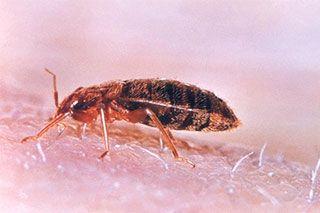
These bloodsuckers originally parasitized bats. The bed bug (Cimex lectularius) has been a familiar human parasite for more than 3,000 years. After a significant decrease in its population density in the middle of the last century, we have seen a dramatic increase again around the world over the past 20 years. In Australia, for instance, there is an increase of 4,500%.
Mostly business travel and tourism are responsible for the renewed spreading of the species - as is its growing resistance to commercially available pesticides. Some bed bug populations exhibit an increase in resistance to pesticides by 10,000.
Decoded genome shows the specie's evolution
The team gained many new insights into those parts of the genome that code receptors for smell and taste: While a high-performance sensor system enables the bed bug to find its host in the dark, many widespread receptor types have disappeared from the bed bug's genome. For example, bed bugs can no longer taste sugar.
Pesticides no longer penetrate the bed bug's shell
In order to sequence the genome, the scientists used a bed bug population that still responds to pesticides (original condition). They determined the genes responsible for the growing insecticide resistance by comparing the genome data of the former to the transcriptomes of insecticide-resistant populations.
It appears that it is not only the altered composition of enzymes that render the pesticides ineffective. Obviously the insect's cuticle, its outer shell, is also becoming increasingly impermeable for pest control agents.
From bats to humans
Cimex lectularius was originally a bat parasite. Since bats often sleep in caves, the transition of bed bugs to humans most likely only occurred a few thousand years ago through their sharing of these shelters. Today's bed bugs are still a single species - whether they feed on humans or bats. However, the researchers were able to show that a genetic differentiation has begun within the species, which becomes apparent in the genome.
"Among other things, the differentiation of the bed bugs specializing in humans lies in the area of chemosensation," Professor Reinhard Predel from the Zoological Institute explains. "Probably they can smell humans better than their conspecifics that parasitize bats."
Nutritional physiology
In contrast to fleas or mosquitos, bed bugs are obligatory blood suckers throughout their various development stages, which is quite a challenge for their digestion and excretion systems, and generally their nutritional physiology. In this regard, few specific adaptions were found in their genome.
"We assume that the bed bug has developed special skills such as hormonal regulation of water balance after a meal through the altered genetic expression of quite common hormones and receptors," Predel notes.
Traumatic reproduction
Last but not least, the researchers attained valuable insights into those parts of the bed bug's genetic constitution that allow the female to survive the traumatic mode of insemination. The Cimex lectularius male penetrates the female's outer shells with its penis. Possible injuries and the risk of infection are decreased through so called resilins, highly elastic proteins in the outer shell. The researchers found a significantly increased number of resilin genes as well as immune system adaptations in the genome.
Source: University of Cologne
 Print Article
Print Article Mail to a Friend
Mail to a Friend
